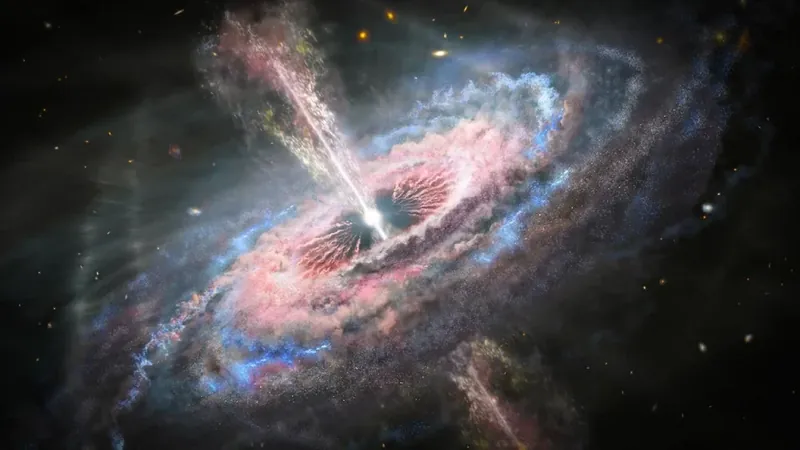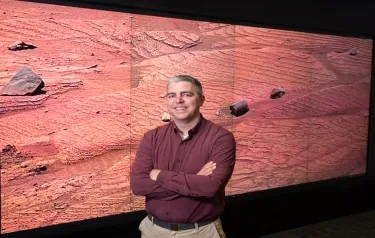
NASA's Hubble Telescope Uncovers Astonishing Details of a Colossal Black Hole
2025-04-10
Author: Sophie
Unveiling the Heart of a Cosmic Powerhouse
Astronomers have taken a groundbreaking step into the core of a dazzling cosmic engine, utilizing NASA's Hubble Space Telescope to obtain an unprecedented close-up of a quasar's heart. Quasars represent some of the universe's most luminous and powerful phenomena, positioned at the centers of galaxies, where black holes gobble up nearby matter and unleash energy that outshines entire galaxies.
Hubble Trains Its Sights on 3C 273
The telescope focused on the iconic quasar 3C 273, a dazzling galactic core located over 2.5 billion light-years away, first identified back in 1963. This quasar has been essential in enhancing our understanding of the growth and interaction of black holes with their surrounding galaxies. Thanks to advanced instruments on Hubble, scientists are now able to observe 3C 273 like never before.
A Striking Closer Look at the Quasar
To grasp how remarkable this new view is, consider the immense challenge faced by the Hubble team. Studying a quasar like 3C 273 is akin to staring into a car headlight while trying to see an ant on the lens's edge—the glare obscures critical details around the black hole.
However, with the Space Telescope Imaging Spectrograph (STIS) acting like a solar eclipse, blocking out a major light source, astronomers could finally dig into the quasar's environment without the blinding intensity getting in the way.
Breathtaking Discoveries in the Cosmic Surroundings
What they uncovered was unexpected. "We observed various blobs of different sizes and a puzzling L-shaped filament structure, all within 16,000 light-years of the black hole," revealed Bin Ren from the Côte d'Azur Observatory in France. These peculiar features could indicate small satellite galaxies spiraling toward 3C 273, potentially fueling the black hole’s immense energy.
Quasars: The Bright Beacons of the Early Universe
Quasars like 3C 273 were most prevalent approximately 3 billion years after the Big Bang during a time of frequent galaxy collisions, often sending massive amounts of matter toward central black holes and igniting their brilliance.
Stunningly, 3C 273 shines over 10 times brighter than the largest known galaxies. If situated just a few dozen light-years from Earth, it would outshine the Sun.
Revealing Hidden Structures
Prior to Hubble's enhanced vision in the 1990s, many scientists viewed quasars as simple entities. However, early Hubble imagery unmasked signs of galactic chaos and intricate behavior around these powerful black holes. This latest research dove deeper than ever, enabling scientists to observe eight times closer to the black hole than previously possible.
Hubble's ultra-clear imaging also unveiled a colossal jet of material extending 300,000 light-years into space, shot from the black hole’s poles at nearly light speed, representing one of astronomy's most extreme phenomena.
Linking Motion and Structure
By comparing fresh data with images from over two decades ago, scientists traced the jet's movement, discovering that portions of the jet seem to accelerate the further they travel from the black hole. This odd behavior likely relates to the jet’s interactions with its surrounding galaxy and the intergalactic expanse.
Hubble: A Continuous Source of Cosmic Knowledge
Hubble's continued exploration of the universe has reshaped our scientific understanding. Even after three decades in space, it consistently unearths revelations about black holes and their intricate links to their host galaxies. With an estimated one million quasars peppered across the cosmos, each serves as a unique lens through which we can explore the formation and evolution of the universe.
These distant cosmic beacons also assist astronomers in mapping the gas and dust that permeate the universe, shedding light on its vast structure.
The Future: Unveiling More Mysteries
Looking ahead, astronomers are eager to utilize the James Webb Space Telescope to study 3C 273 in infrared, which could yield even more insights into the dust and stars surrounding the black hole. With cutting-edge technology, the quest to unravel the mysteries of quasars is just beginning.









 Brasil (PT)
Brasil (PT)
 Canada (EN)
Canada (EN)
 Chile (ES)
Chile (ES)
 Česko (CS)
Česko (CS)
 대한민국 (KO)
대한민국 (KO)
 España (ES)
España (ES)
 France (FR)
France (FR)
 Hong Kong (EN)
Hong Kong (EN)
 Italia (IT)
Italia (IT)
 日本 (JA)
日本 (JA)
 Magyarország (HU)
Magyarország (HU)
 Norge (NO)
Norge (NO)
 Polska (PL)
Polska (PL)
 Schweiz (DE)
Schweiz (DE)
 Singapore (EN)
Singapore (EN)
 Sverige (SV)
Sverige (SV)
 Suomi (FI)
Suomi (FI)
 Türkiye (TR)
Türkiye (TR)
 الإمارات العربية المتحدة (AR)
الإمارات العربية المتحدة (AR)